|
Valve Developments
This was the first Olympia show since 1939.
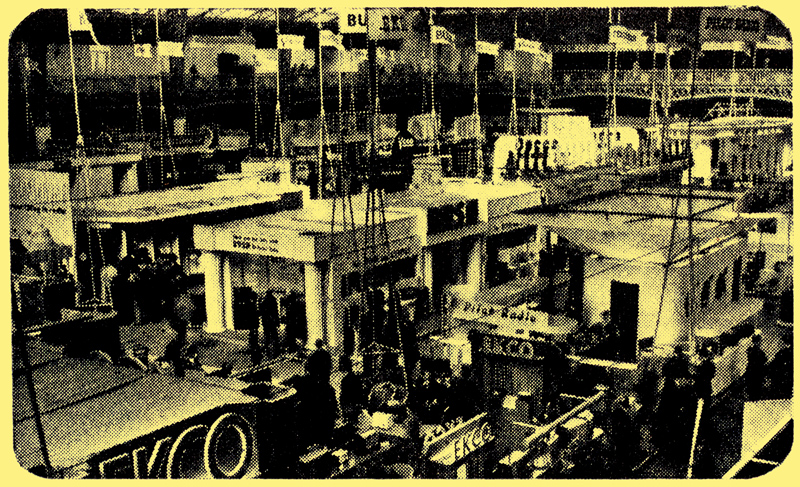
The exhibition hall.
Although all makers of valves were showing examples, and in some cases almost complete ranges, of the all-glass baseless style of construction, the current types on octal bases are likely to remain the mainstay for some time yet to come. There is nothing spectacular in the characteristics of the all-glass type, and their mutual conductances are very much the same as the equivalent pattern in current ranges. They are, however, more efficient at the television and the very high frequencies, since they are physically smaller and have much shorter internal connections to the pins and, of course, there is no base material, except glass, so that losses are kept down to a minimum.
The all-glass valves exemplify the style of construction to be adopted by the industry for the proposed standardization scheme. The majority will have a small 8-pin base with their pins disposed around a circle of 11.5 mm diameter. This is known as the B8A, and there is a centre spigot and a locating boss on the side of the base. A bayonet type valve-holder is thus required.
Output valves and those needing a large bulb are being fitted with a slightly larger version of this base, and it is now described as the B8B. This is similar to the 8-pin Loctal base. There is also a button-type 7 pin base for the very small miniature valves, and this is known as the B7G.
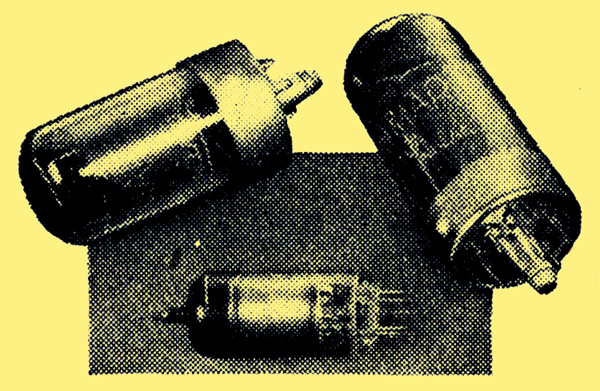
Three of the latest Brimar valves, the 7H7 and 7Z4 on Loctal bases and the 9D6 miniature RF pentode.
The Brimar range of valves shown by Standard Telephones included a series described as Loctal types fitting the B8B base and having a lock-in locating spigot carried on a false metal base. This has clearance holes through which the base pins project, the valve being an all-glass type. The series includes 1.4 Volt battery valves taking 50 mA filament current as well as 6.3 Volt mains types. In the latter type the 7H7 variable-mu RF pentode has a mutual conductance of 3.8 mA/V. In addition, Brimar now have a series of miniature types for the B7G holder for 1.4 Volt and 6.3 Volt operation.
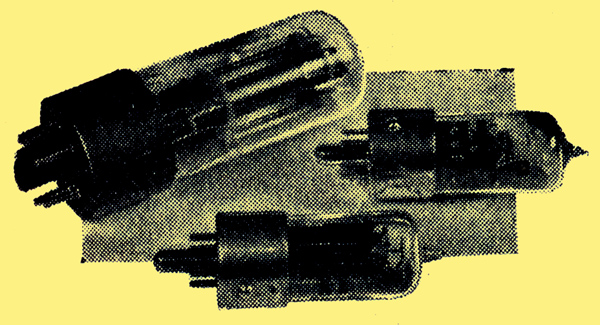
Three of the latest Mazda valves, showing the types 10C1, 10P14 and 10LD11.
Some AC/DC valves consuming 100 mA of heater current and fitting the smaller B8A base are made by Mazda. These are identifiable by the serial number 10 with additional letters and figures according to the type and function of the valve. The 10F9, for example, is an indirectly heated RF pentode with a μ of 2.4 mA/V and operating with 175 Volts on the anode and 100 on the screen. The corresponding frequency changer is a triode-hexode with a conversion conductance of 0.65 mA/V and taking the same anode and screen voltages. The triode requires 80 Volts at 4.5 mA. A double diode triode, output tetrode and half-wave mains rectifier are included. Mazda also had a few miniature types for the B7G base.
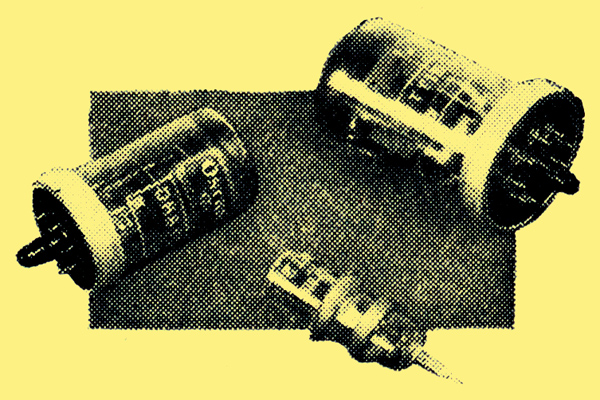
Some of the latest types of Osram valves showing the DET22 grounded grid triode, TT15 double RF tetrode and DH81.
A short series of 8-pin all-glass valves, including a variable-mu RF pentode (W81), with a μ of 2.8 mA/V, a double diode triode (DL82), output tetrode (KT81) and a triode-hexode frequency changer (X81M) are produced by GEC These are 6.3 V types. There are also a few specimens of miniatures with the B7G base arrangement of pins, also for mains operation, one being the Z77 a high-slope RF pentode with a μ of 7.5 mA/V developed especially for television receivers. Another special Osram type is the KT45, an output tetrode for the line scan time base. It operates at 4,000 Volts on the anode and 300 on the screen.
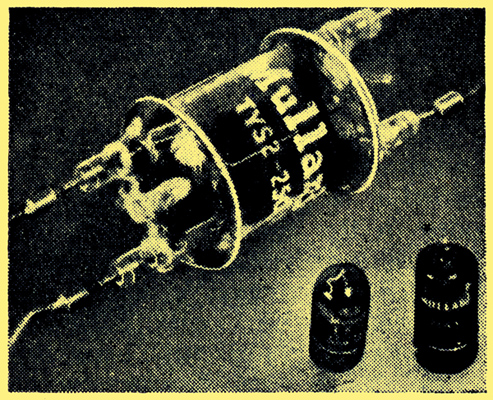
Mullard silica. valve Type TYS2-250, and two of the new miniatures, EF42 and EF91.
Miniature all-glass valves shown by Mullard are mainly for use in industrial equipment, There were a few samples of the valves that will eventually be produced for domestic receivers, with the small B8A pin arrangement. Mullard were making a special display of industrial-type valves, among which were a range of silica transmitting triodes for use in radio heating equipment. These silica types can be run at very high temperatures, and generally require no assisted cooling. The smallest in the range, while not a large valve, will give an output of 720 Watts RF at 50 MHz.
Another interesting Mullard development is an accelerometer valve giving an output proportional to acceleration. It has many applications in industrial electronics; one, for example, being the control of acceleration of lifts. Mullard is now producing a number of special VHF transmitting valves of low and medium power for use in mobile and aircraft equipments. The QV04-7, QV05-25 (807 equivalent), QV04-20 (815 equivalent) and, most recent of all, the QQV07-40 (829B) equivalent) are types that will appeal also to amateur transmitters. The last two mentioned are double tetrodes in one envelope.
Comparable GEC types are the TT11, a single RF tetrode. and the TT15, a double assembly suitable for use up to at least 100 MHz in small transmitters.
For centimetre operation in radar equipment GEC were showing some grounded-grid triodes in the form of the DET22, for use down to 10 cm wavelength and the ACT22 and ACT23, which are used in the London-Birmingham experimental television link system on centimetre wavelengths.
During the war enclosed crystal rectifiers were developed for use in the centimetre radar equipment. Their construction has been described in this journal. These stable silicon crystal rectifiers were shown at this exhibition by BTH together with a more-robust variety which has been developed for use in television sets, test and servicing equipment requiring a diode-type rectifier capable of functioning efficiently up to about 100 MHz. The fact that it needs no filament supply is an added attraction for test gear purposes. Described as the: BTH Germanium crystal rectifier, it will pass a continuous crystal current of 50 mA DC. The rectifier is comparable in size to a 0.25 W resistor and has similar end connecting wires.
Cathode ray tubes for television use vary in size from about 9 in to 15 in diameter. They are now almost exclusively focused and deflected by magnetic means, the electrostatic principle being confined to the instrument types.
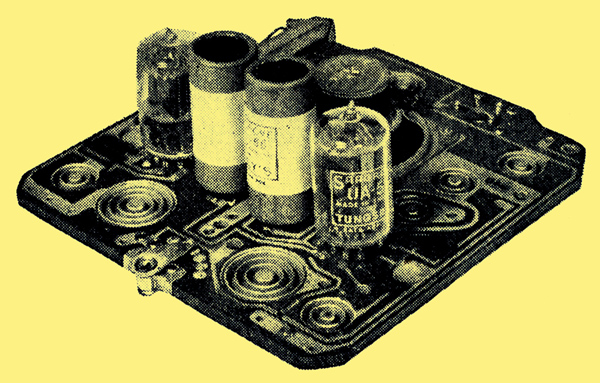
Sargrove all-stage valves, shown by Tungsram, fitted on a chassis with components 'sprayed on' by the ECME process.
|